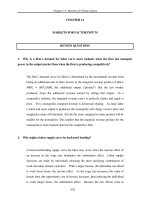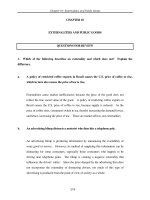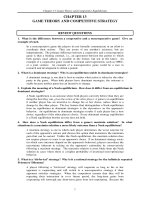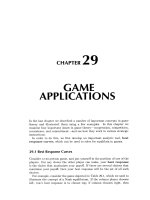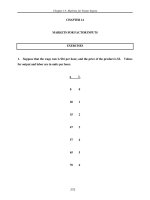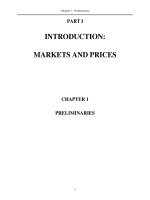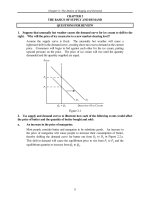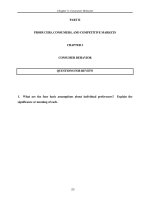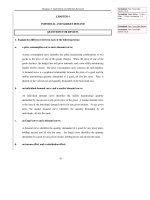Câu hỏi đánh giá môn Kinh tế vĩ mô bằng tiếng Anh- Chương 14
Bạn đang xem bản rút gọn của tài liệu. Xem và tải ngay bản đầy đủ của tài liệu tại đây (46.86 KB, 5 trang )
Chapter 14: Markets for Factor Inputs
232
CHAPTER 14
MARKETS FOR FACTOR INPUTS
REVIEW QUESTIONS
1. Why is a firm’s demand for labor curve more inelastic when the firm has monopoly
power in the output market than when the firm is producing competitively?
The firm’s demand curve for labor is determined by the incremental revenue from
hiring an additional unit of labor known as the marginal revenue product of labor:
MRP
L
= (MP
L
)(MR), the additional output (“product”) that the last worker
produced, times the additional revenue earned by selling that output. In a
competitive industry, the marginal revenue curve is perfectly elastic and equal to
price. For a monopolist, marginal revenue is downward sloping. As more labor
is hired and more output is produced, the monopolist will charge a lower price and
marginal revenue will diminish. All else the same, marginal revenue product will be
smaller for the monopolist. This implies that the marginal revenue product for the
monopolist is more inelastic than for the competitive firm.
2. Why might a labor supply curve be backward bending?
A backward-bending supply curve for labor may occur when the income effect of
an increase in the wage rate dominates the substitution effect. Labor supply
decisions are made by individuals choosing the most satisfying combination of
work and other (leisure) activities. With a larger income, the individual can afford
to work fewer hours: the income effect. As the wage rate increases, the value of
leisure time (the opportunity cost of leisure) increases, thus inducing the individual
to work longer hours: the substitution effect. Because the two effects work in
Chapter 14: Markets for Factor Inputs
233
opposite directions, the shape of an individual’s labor supply curve depends on the
individual’s preferences for income, consumption, and leisure.
3. How is a computer company’s demand for computer programmers a derived demand?
A computer company’s demand for inputs, including programmers, depends on how
many computers it sells. The firm’s demand for programming labor depends on
(is derived from) the demand it faces in its market for computers. As demand for
computers shifts, the demand for programmers shifts.
4. Compare the hiring choices of a monopsonistic and a competitive employer of workers.
Which will hire more workers, and which will pay the higher wages? Explain.
Since the decision to hire another worker means the monopsonist must pay a higher
wage for all workers, and not just the last worker hired, its marginal expenditure
curve lies above the input supply curve (the average expenditure curve). The
monopsonist’s profit-maximizing input demand, where the marginal expenditure
curve intersects the marginal revenue product curve, will be less than the
competitor’s profit-maximizing input choice, where the average expenditure curve
intersects the demand curve. The monopsonist hires less labor, and the wage paid
will be less than in a competitive market.
5. Rock musicians sometimes earn over $1 million per year. Can you explain such large
incomes in terms of economic rent?
Economic rent is the difference between the actual payment to the factor of
production and the minimum amount that the factor is willing to accept. In this
case, you might assume that there are a limited number of top-quality rock
musicians who will continue to play rock music no matter what they are paid.
This results in a perfectly inelastic supply curve, or something close to it. Given
Chapter 14: Markets for Factor Inputs
234
the high demand for rock music, the wage will be very high and there will be a lot
of economic rent. If there was a larger supply of top-quality rock musicians, or a
more elastic supply, then the economic rent would be smaller.
6. What happens to the demand for one input when the use of a complementary input
increases?
If the demand for the complementary input increases, the demand for the given
input will increase as well. When demand for the complementary input increases,
there is an increase in the quantity hired and possibly the price paid. Both of these
changes will increase the MRP of the given input, and hence will increase the
quantity hired and possibly the price paid. Whether the prices of the inputs
increases depends on the degree of monopsony power on the part of the firm.
7. For a monopsonist, what is the relationship between the supply of an input and the
marginal expenditure on it?
The decision to increase employment means the monopsonist must pay all units the
higher price, and not just the last unit hired. Therefore, its marginal expenditure
curve lies above the input supply curve (the average expenditure curve). Hiring
more labor will increase the marginal expenditure, which will increase the average
expenditure. If the average expenditure is increasing, then the marginal
expenditure must be greater than the average expenditure.
8. Currently the National Football League has a system for drafting college players by
which each player is picked by only one team. The player must sign with that team or not
play in the league. What would happen to the wages of newly drafted and more experienced
football players if the draft system were repealed, and all teams could compete for college
players?
Chapter 14: Markets for Factor Inputs
235
The National Football League draft and reserve clause (a primary issue in the 1987-
1988 season’s strike) creates a monopsonist cartel among the owners of NFL teams.
If the draft system were repealed, competition among teams would increase wages
of football players to the point where the marginal revenue product of each player
would be equal to the player’s wage.
9. The government wants to encourage individuals on welfare to become employed. It is
considering two possible incentive programs for firms.
A. Give the firm $2 per hour for every individual on welfare who is hired.
B. Give each firm that hires one or more welfare workers a payment of $1000 per
year, irrespective of the number of hires.
To what extent is each of these programs likely to be effective at increasing the
employment opportunities for welfare workers?
Firms will hire additional labor as long as the extra benefit is greater than the
extra cost of hiring the worker, or until MRP
L
= w. Option A would be effective
because if the firm receives $2 per hour for every welfare worker hired then the
effective wage paid, w, will fall and the firm will find it optimal to hire more
labor until the benefits (MRP
L
) again equal the costs (w) at the margin. Option
B would be effective at increasing employment opportunities also in that if the
firm hires an individual who has been on welfare they will then receive $1000.
However, plan B is not necessarily as effective as plan A given the firm only
receives one lump sum payment regardless of the number of welfare workers
hired. In this case the firm only has an incentive to hire the one welfare worker,
though they may of course choose to hire more than one welfare worker.
Chapter 14: Markets for Factor Inputs
236
10. A small specialty cookie company, whose only variable input is labor, finds that the
average worker can produce 50 cookies per day, the cost of the average worker is $64 per
day, and the price of a cookie is $1. Is the cookie company maximizing its profit?
Explain.
The marginal product of labor is 50 (cookies per day) and the price per cookie is 1
($ per cookie) so the marginal revenue product is $50/day. Since this is less than
the wage of $64 per day the cookie company is not maximizing profit. They are
employing too much labor since the cost of labor is greater than the benefit of
labor at the margin, and are therefore producing too many cookies.
11. A firm uses both labor and machines in production. Explain why an increase in the
average wage rate causes both a movement along the labor demand curve and a shift of the
curve.
An increase in the wage rate causes an upward movement along the labor demand
curve. For any given marginal revenue product curve, the firm will find that
they want to hire fewer workers when the wage increases (an upward movement).
However, when the wage increases the marginal cost will increase which will
reduce desired output. When output falls, the firm will not need as many
machines and the marginal product of labor curve will shift to the left, assuming
machines and labor are complementary. This will also reduce the demand for
labor.
